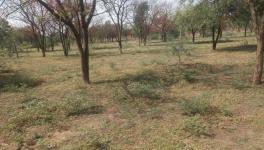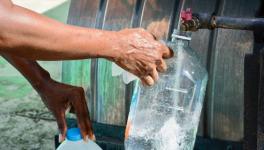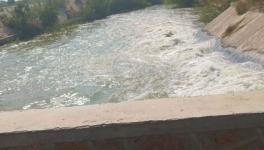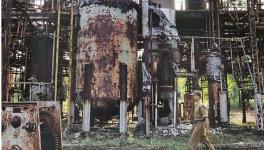Buddha Nullah: From A Seasonal Water Stream to A Stinking Drain
Image Courtesy : The Tribune
When 43% of the country is reeling under drought and worst water-crisis in its history, it's really ironic that Punjab, the land of five rivers, is going through one of its kind of fatal anthropogenic water-crisis. The waters of Punjab have become heavily contaminated with metals and other deadly pesticides, to an extent that the state became infamous as the cancer capital of India. And at the epicentre of this hazard is Buddha Nullah, once an important source of freshwater for Ludhiana, which is now no less than a dumping ground for domestic and industrial waste of the city.
The story of Buddha Dariya (river), as once known, turning into Buddha Nullah (drain) portrays how grim the situation is in Punjab. Buddha Nullah is a tributary of Sutlej which flows through the industrial city of Ludhiana. The highly polluted stream carries the untreated industrial toxic effluents and domestic sewage waste into the Sutlej river. The water is so contaminated that it is suspected to have caused genetic mutations in the population of the region, as per a study of Punjab Pollution Control Board (PPCB).
According to the Action Plan report for Clean River Sutlej, 2019, the river enters the State of Punjab with Class-B quality of water, which remains Class-C upstream the point of confluence of the river with Buddha Nullah, and emerges with Class-E quality of water downstream the point of confluence. The test report of Quality of Water of Polluted River Stretches in Punjab for April 2019 by Punjab Pollution Control Board suggests that the concentration of Biological Oxygen Demand of Sutlej was found in the range of 1.0 to 3.0 mg/l upstream of the confluence with Buddha Nullah, but 100 metres downstream the confluence, the BOD of Sutlej suddenly shoots up to 90mg/l.
Also read: Ganga in Deeper Troubled Waters Than Ever, So Much for Modi’s ‘Namami Gange’
Going by the norms and permissible limits set by Central Pollution Control Board (CPCB), the river water is fit for bathing if the fecal coliform count is between the desirable limit of 500 and a maximum permissible limit of 2,500 Most Probable Number/100 ml. The data published by PPCB reveals the total coliform bacteria count in the Sutlej downstream the confluence is at 22,00,000 MPN/100ml i.e.,100 times above the permissible limit, making it unfit for even bathing purpose. Fecal coliform is an indicator of bacterial contamination either from sewage disposal or directly from humans and other warm-blooded animals.
Genetic Mutations in Malwa Region and Cancer Train
In addition to pesticides, contamination from industrial effluent, domestic sewage, industrial effluent containing deadly chemicals and heavy metals seep under the ground, contaminating the groundwater. The bioaccumulation and biomagnification of these pollutants and carcinogens have had a deadly effect on the populace of the Malwa region. A steady increase has been seen in the cases of Down's syndrome, Cerebral palsy, premature ageing among other physical and mental abnormalities. A study by the researchers of Post Graduate Institute of Medical Education and Research (PGIMER), Chandigarh has found that children are worst affected by the impact of contamination. The blood samples collected from people living along the drains in areas of Ludhiana, Amritsar, and Jalandhar revealed that 65% of the cases had a varying degree of DNA mutations. The Malwa region has the highest rate of cancer incidence in India with Muktsar outranking other districts with 136 patients per 100,000 people of its population. While the national average of cancer incidence rate stands at 106 per 100,000 people.
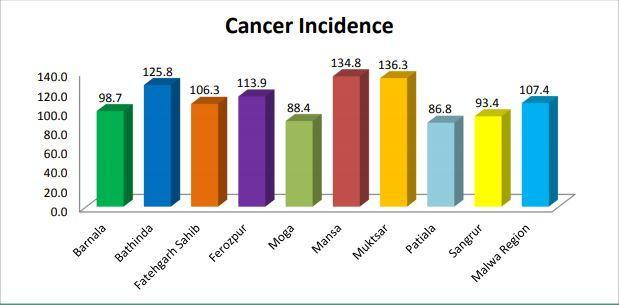
Courtesy http://pbhealth.gov.in/cancerawareness/Outcome.pdf: Punjab State Report on Cancer Awareness and Symptom Based Early Detection, Sate Wide Door to Door Campaign
The impact of pollution in Buddha Nullah has trespassed the geographical boundaries of the neighbouring state Rajasthan. Indira Gandhi Canal, the longest canal in the world, which emerges from Harike Barrage is fed by River Sutlej and Beas. The same contaminated water of Sutlej reaches Rajasthan through the canal, replicating similar health crisis as in Punjab. There is a sudden surge in the number of cancer patients travelling from various parts of Malwa region to Bikaner for diagnosis and treatment at the Acharya Tulsi Regional Cancer Treatment and Research Institute, one of the 25 Regional Cancer Centres across the country. The magnitude of the crisis can be assessed from the fact that the train that carries these patients and their family members every day from stations of southern Punjab to the facility in Bikaner, has acquired the notoriety of ‘Cancer train’. On an average 100 cancer patients suffering from cancer travel every day by this train to the facility.
Control measures taken in the past to mitigate the menace
Numerous attempts have been made by the state government and its various agencies in the last 30 years for curbing pollution, but the pollution levels have only increased. A lack of political will and the absence of penalty and punitive measures against those who contribute to pollution has failed to deter the defaulters. According to a report by Citizen Matters, the state and central governments have together spent Rs 550 crore in the last 30 years to clean up the drain. In 2009, Ludhiana district administration imposed Section 144 of the Code of Criminal Procedure (CrPC) in the vicinity of Buddha Nullah and dumping of garbage was stopped immediately by ensuring police patrolling but everything was forgotten soon. In April 2011, an attempt for In Situ Bio-remediation was launched by the former Environment and Forest Minister Jairam Ramesh to curb the contamination in Buddha Nullah. The water of the stream was so toxic that even the bacteria released into it for the biological cleaning up process failed to grow.
Also watch: How Much Plastic Do You Consume?
After years of inaction and lack of sensitivity towards the environment, the National Green Tribunal (NGT) in the matter of Shobha Singh Vs State of Punjab directed the Central Pollution Control Board to constitute a Monitoring Committee with the involvement of environmentalist Balbir Singh Seechewal, known for cleaning 164-km-long highly polluted Kali Bein rivulet with the help of his followers. In 2018, a Special Task Force (STF) headed by Namdhari sect head, Thakur Uday Singh, was also created to start the cleaning process. The Monitoring Committee submitted its interim report, upon which NGT following the Polluter Pays Principle directed the State of Punjab to deposit a sum of Rs 50 crore with CPCB to restore the damage caused to the environment by its erring bodies.
Understanding Water Crisis and the Way forward
Jamshedpur has become India’s first city to become a zero sewerage discharge city. Zero sewerage water discharge is achieved by a technology called Zero Liquid Discharge (ZLD), a water treatment process in which the wastewater is purified and recycled in a way that leaves zero discharge at the end of the treatment cycle, therefore eliminating wastewater discharge into nearby water bodies. Despite its successful implementation, the technology has not been replicated in any other place. This wastewater treatment plant in Jamshedpur treats 40 Million Litre per Day (MLD). The total wastewater of Ludhiana discharged into river Sutlej is estimated about 700 MLD which includes industrial effluent. This is not a big feat to achieve, provided the government shows due sensitivity towards the ailing health of the people and its economy. Paradoxically, the government acting dismissively, has come out with a Composite Water Management Index (CWMI) Report, 2018, which suggests Punjab is the only state to have installed capacity for treating 100% of its wastewater, which is considerably incoherent with the reports of State Government, PPCB and NGT.
If the government is at all serious about eradicating the menace of water contamination, then it should start with strict effect the accepted rule of Customary International Law, which has also been imbibed in the municipal law by the Supreme Court in its judgement in Indian Council for Enviro-Legal v. Union of India. The Polluter Pays Principle simply imposes 'absolute liability' on a person polluting the environment. The liability not only extends to compensate for the damage caused to the victims of pollution but also the cost of restoring environmental degradation. The principle shifts the onus to compensate the victim and cost of remediation from the state to the polluter. When everything fails and there is no hope of rectification, punitive sanctions are the only way to build a larger consciousness and sensitivity among those involved in polluting the environment.
Also read: ‘Deepak Nitrite Releasing Hazardous Industrial Waste Under Gujarat Govt’s Nose’
There is a need to strictly implement the provisions of the Water Act which prohibits the use of streams and wells for disposal of waste and effluents to deter the polluters from causing irreversible damage to the environment. We cannot afford any further delay in adopting mitigation measures when India is already experiencing the worst water crisis in its history. Continued water contamination will only have adverse implications on food production, biodiversity, and the health of the dependent population.
Get the latest reports & analysis with people's perspective on Protests, movements & deep analytical videos, discussions of the current affairs in your Telegram app. Subscribe to NewsClick's Telegram channel & get Real-Time updates on stories, as they get published on our website.











